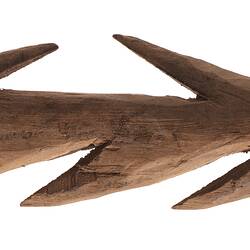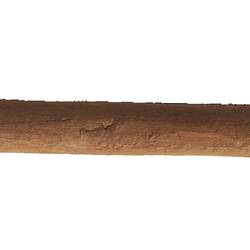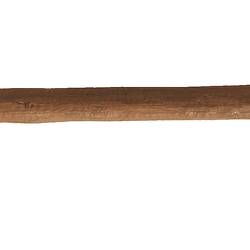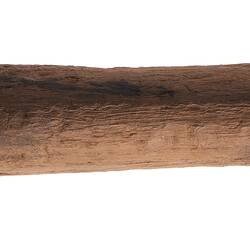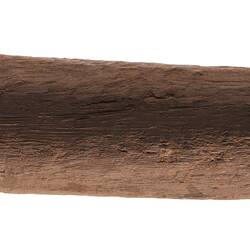Summary
Aboriginal man Albert Murphy carved this spear from a single piece of solid wood, and it features a bi-lateral barbed head; the barbs curve downwards, with just one barb curved upward. Spears were used mainly for fishing and hunting, as well as during battle and could be made from a variety of plant materials.
Albert Murphy carved this spear in the early 20th century, during his time at Mount Olive Aboriginal Reserve. Although no record of Albert Murphy's nation has yet been found it is likely he belonged to one or more of the groups whose people's traditional land originally encompassed this area. These peoples include the Wonnarua, the Awabakal, the Worimi and the Darkinjung.
Mount Olive, originally named St Clair Mission, was established by Reverend J. S. White and covered 60 acres (24.28 hectares) of land in Carrowbrook, eastern New South Wales. People living there in its early years farmed the land and continued to hunt using their traditional spears. The records indicate that Albert Murphy was granted a piece of land at St Claire in 1899.
The Aborigines Protection Board took over the mission and renamed it in 1918, with manager T. H. Austin's strict rules resulting in the removal of many Aboriginal people and its eventual closure in 1923.
As most of the people had left the old camp, Albert Murphy went to Aberdeen to reside with friends. He was well-known for miles in the area and was always on the lookout to lend a hand to people traversing the water at Carrowbrook, as he knew the crossing well. He would go through flooded waters to take rations to the mothers who had no help, and would return with them on his head, the water reaching his chin
Physical Description
Solid, carved in one piece, plain. Barbed head consists of bi-lateral barbs carved in a downward orientation, with one barb carved in an upward or reverse orientation. Butt tapers.
Significance
Since 1990s the Wonnarua Aboriginal Nations Corporation has fought long and hard to reclaim the former St Clair Mission site which includes a historic corroboree site. In the late 1990s, after a long campaign, the Wonnarua Aboriginal Nations Corporation was granted control of the site. The Mission is a heritage homeland for many children of the Stolen Generations who were taken from their families and communities, many of whom are unable to trace their heritage back any further than the Mission.
In 2013 two sites on the former St Claire Mission were declared Aboriginal Sites by the New South Wales Government. The Mission Church School and the Corroboree Ground at the site have been recognised for their special cultural, spiritual, social and historic significance having strong cultural meaning and connection for the Wonnarua, the Awabakal, the Worimi and the Darkinjung peoples and their descendants from across the State. Plans are underway to turn the former mission into a cultural centre. Wonnarua Elder and Aboriginal Nations Corporation Chief Executive Laurie Perry speaks of the importance of a cultural centre on the site;
"It can serve as a place of education and also provide employment opportunities but it is also a chance to make sure the story of our people is heard." Laurie Perry, 2013.
More Information
-
Object/Medium
Spear
-
Maker
-
Locality
-
Date Produced
-
Object Measurements
1850 mm (Length), 23 mm (Width), 23 mm (Height)
-
Classification
-
Date Made
-
Maker
-
Clan/Language Group
-
Place Made
-
Indigenous Region
-
Keywords
-
Type of item
-
Discipline
-
Category
-
Collecting Areas

